#intertissued
Text
White BBW Slut Makes BBC Cums Twice All Over Her Face As She Has A Major Orgasm At The Same Time
Crystal Lopez has pussy shattered
Indo twunk hides away to shoot cum
Novinha sentando com gosto
Bajo falda corta a rubia logre grabarle las nalgas
Seductive and alluring pornstar goes for a blind date with a wicked chap
Sexy Teen Virgin Step Sister Mandy Muse Lets Step Brother Fuck Her In The Ass
Coroa folgosa do Casal HIWA do Sexlog fudendo com comedor
Older Blonde Robin Pachino Gets Fucked Poolside
Stud Fraser Jacs fucking UK ass and throat before cumshot
#phragma#calliperer#Bhola#quercinic#drapability#opalescence#slow-legged#newsboat#dentellated#unvulnerable#potions#supersaturating#intertissued#ballooners#ringtime#sovereign's#triggest#gibbals#tmz#superevidence
1 note
·
View note
Text
Lustful slut is pissing and is drilling pussy in a sex game
Lesbico dunia montenegro y jordanne kali
Spex teen loves getting fucked by grandpa
Young boys big ass gay They sat back down on the futon, Nathan
Sexy milf Ryder Skye has the anal squirting orgasm
My boyfriend watches me masturbate
Sexy Big Ass Magician Teen Step Sister Jade Jantzen Makes Her Step Brothers Cock Disappear In Her Pussy And Ass POV
Desi Lund tilt
Cute teen Emma Starletto
Super oiled anal cowgirl Kimber Woods
#intertissue#shilly-shallied#spoutless#xanthomatosis#hagbushes#Polygonaceae#husbandship#asheries#ethologists#twentyfold#weakliness#compactable#boxholder#Val#gagroot#culmed#cinemagoers#pliciform#Idledale#larree
0 notes
Text
“O ceremony, show me but thy worth!
What is thy soul of adoration?
Art thou aught else but place, degree, and form,
Creating awe and fear in other men, (...)
I am a king that find thee, and I know
'Tis not the balm, the scepter, and the ball,
The sword, the mace, the crown imperial,
The intertissued robe of gold and pearl,
The farcèd title running 'fore the king,
The throne he sits on, nor the tide of pomp
That beats upon the high shore of this world.”
Shakespeare, Henry V -- c. 1599
1 note
·
View note
Note
Okay I am having MASSIVE FEELS over this paper I'm writing, about H5.4.1 and R2.4.1 and Henry's understanding that he's just a man under all the ceremony and titles and robes and it reminded me of the line in "Superman" by Five For Fighting-- "I'm only a man in a funny red sheet." I can't put that in my paper so I'll just cry about it here.
Please, cry! And I will cry with you. And we will flood the angels out of heaven itself with our tears, because the man who wears the crown is still a man.
It is the most awful truth in the entire Henriad and it becomes the loneliest realization for Richard, for Henry, and finally for Hal. The balm, the crown, the duty’s rights, the sceptre and the ball, the sword, the mace, the crown imperial, the intertissued robes of gold and pearl…all of them, altogether, all those pieces combined, amount to nothing more than a funny red sheet, in the end. As David Tennant so poignantly put it during an interview for the RSC’s Richard II: “It is the most devastating thing in the world, to finally understand that the angels aren’t coming.”
But this fact — that wearing the king’s crown doesn’t sap the humanity from a man’s soul — is also, I think, the only true source of redemption in the entire tetralogy, because the great hope of humankind lies in our ability and willingness to improve ourselves and the world around us. And we will not, we cannot, strive to make ourselves wiser, kinder, or more just if we see ourselves as inherently infallible, divine, or exempt from the laws of man. Richard’s bitter, fourth-act recognition that sitting on a throne doesn’t turn a man’s blood to ichor is balanced so beautifully in the play by the gossamer connections he is then able to forge in Act 5 with his queen (whom he sends away to safety) and his old groom (whom he thanks and then sends away to safety). God’s angels may not have come to save him, but the angels of his better nature win the battle against his own vanity and he dies so bravely, with his humanity intact.
Fifteen short years later, Hal’s late-night, rain-soaked epiphany that a king is nothing more than a man is precisely what enables him to fight like he has nothing to lose. He doesn’t carry one shred of complacency onto the field of battle on the morning of St. Crispin’s Day; in fact, he’s pretty much resigned himself to his own death. And that’s a huge factor in the English victory.
Then, when he survives, and the fatalities of the battle are read off a scrap of parchment, I think Henry is forced to confront the reality of what ordinary men are capable of. Does the mass slaughter of Agincourt imply that he is something even LESS than a man? Is there any humanity left in him at all, or is he just a man-shaped shell, a husk? I would argue it’s not until he meets Catherine that Hal finally discovers the salvation of his maxim that a king is just a man. Because if ordinary men are capable of extraordinary destruction, then that means they must also be capable of extraordinary love. And every time he makes this French princess laugh, whether intentionally or not, he gets closer and closer to reclaiming his humanity. His courtship succeeds not because he wows her with his godlike glory, but because he lets himself be a messy human in front of her. The fact that all the gilded objects on earth cannot protect a king from mortality is precisely what enables Hal to be vulnerable in front of the one person who can make him happy.
Perhaps my favorite motif in the Henriad is the constant textual conflation of humanity and music. Songs are often wrapped up with elements of the human condition: souls, madness, wisdom, friendship, grief, spousal love. Music is a shared language in these plays; one might even call it a universal language, in the same way that the soul is a universal human feature. Falstaff & Friends carouse to the tune of drinking ditties on their way to, from, and around the edge of battle. Lady Mortimer sings in Welsh to her English-speaking husband who can’t understand a word, but treasures the love she pours into every note. Catherine’s broken English sounds to Hal like the sweetest song on earth, and he begs her to keep speaking. It’s almost like Shakespeare is trying to say something about the inherent beauty of humans — that even though we are earthbound creatures, we are capable of creating gorgeous noise and melodies that resonate across language barriers, class divides, and ideological differences.
Never is this link between personhood and music clearer or more heartrending than in the parallel Shakespeare draws between Richard’s final moments alive and Hal’s chosen penance for Richard’s death:
“This music mads me; let it sound no more,For though it have holp madmen to their wits, In me it seems it will make wise men mad. Yet blessing on his heart that gives it me! For ‘tis a sign of love; and love to Richard Is a strange brooch in this all-hating world…”
(Richard of Bordeaux, Richard II; Act V, scene v)
“…and I have built Two chantries, where the sad and solemn priests Sing still for Richard’s soul…”
(King Henry V, Henry V; Act IV, scene i)
Yes, a king is just a man. But to be a man is to have a soul. And to have a soul is to be worth singing about.
2 notes
·
View notes
Text
Shakespeare Linguistic Item #4
If any of you wanted a count and ranking of the use of the word “crown” (and its variants) in the history plays, here she is (I didn’t have time to do this, but I did it anyway).
3H6 (Henry VI, Part 3) uses “crown” the most at 56 occurrences throughout the play, reflecting just how crazy things got during that glorious disaster of a cycle.
“The lord protector lost it, and not I:
When I was crown'd I was but nine months old.” (Henry VI - I.i.)
H8 (Henry VIII) uses “crown” the least with only seven occurrences. I haven’t read H8 but make of that what you will for the people who have.
“Speak on:
How grounded he his title to the crown,
Upon our fail? to this point hast thou heard him
At any time speak aught?“ (Henry VIII - I.ii.)
Here are the full rankings (most to least by number of occurrences):
1) 3H6 - 56
2) 2H6 - 33
“We thank you, lords. But I am not your king
Till I be crown'd and that my sword be stain'd
With heart-blood of the house of Lancaster” (Richard of York - II.ii).
3) R3 - 22
“By nothing; for this is no oath:
The George, profaned, hath lost his holy honour;
The garter, blemish'd, pawn'd his knightly virtue;
The crown, usurp'd, disgraced his kingly glory.
if something thou wilt swear to be believed,
Swear then by something that thou hast not wrong'd” (Queen Elizabeth - IV.iv).
4) R2 - 19
“On this side my hand, and on that side yours.
Now is this golden crown like a deep well
That owes two buckets, filling one another,
The emptier ever dancing in the air,
The other down, unseen and full of water:
That bucket down and full of tears am I,
Drinking my griefs, whilst you mount up on high.” (Richard II - IV.i.)
5) H5 - 18
“I am a king that find thee, and I know
'Tis not the balm, the sceptre and the ball,
The sword, the mace, the crown imperial,
The intertissued robe of gold and pearl,
The farced title running 'fore the king,
The throne he sits on, nor the tide of pomp
That beats upon the high shore of this world,
No, not all these, thrice-gorgeous ceremony,
Not all these, laid in bed majestical,
Can sleep so soundly as the wretched slave” (Henry V - IV.i.)
6) 1H6 - 14
“Then swear allegiance to his majesty,
As thou art knight, never to disobey
Nor be rebellious to the crown of England,
Thou, nor thy nobles, to the crown of England.” (Richard of York - V.iv.)
7) King John - 13
Doth not the crown of England prove the king?
And if not that, I bring you witnesses,
Twice fifteen thousand hearts of England's breed,—” (King John. II.i.)
8) 2H4 - 12
“Uneasy lies the head that wears a crown.” (Henry IV - III.i.)
9) 1H4 - 8
“But soft, I pray you; did King Richard then
Proclaim my brother Edmund Mortimer
Heir to the crown?” (Hotspur - I.iii.)
10) H8 - 7
#gonna go read H5 again bye#i feel like I've read that play at least 5 times#and i still don't know it well enough#that speech mirrors h6's molehill speech from 3H6 it's beautiful#send me your H5 things I want to be enlightened#the history plays#linguistic shakespeare#no one had time to do this but i did it anyway#fairly reflective of what's going in in the plays#which is pretty cool#shakespeare#right on queue#now the word crown looks and sounds really funny
2 notes
·
View notes
Text
LEADER BIOMEDICAL - Providing a physical barrier to intertissue adhesions
LEADER BIOMEDICAL – Providing a physical barrier to intertissue adhesions
Leader Biomedical is a medical devices company that specialises in marketing and distributing targeted therapeutic solutions for dental, spine, joint care, and sports medicine indications, developing process technologies, and manufacturing innovative biomaterials.
Leader Biomedical is committed to extending the reach of patients and caregivers worldwide. We do this by marketing and distributing…

View On WordPress
0 notes
Text
[III. PRINCIPLE OF PENETRATION BY BORING - cont'd]
B. The forms of intertissual penetration may be even more complex [than, e.g., of cancers or of tissue-selective effects]:
1. In affecting the investing membrane of the heart, pericarditis may cause
a functional disorder resulting in hypertrophy of the organ
therefore a modification of its muscular substance
2. At its origin, pleurisy concerns only the pleura of the lung; but as a result of the disease, the pleura may secrete an albuminous liquid which, in chronic cases, covers the whole lung;
the lung atrophies
its activity is diminished to the point of an almost total cessation of its functioning
it is then so reduced in surface and volume that it seems as if most of its tissue has been destroyed
– Michel Foucault, The Birth of the Clinic: An Archaeology of Medical Perception, (Chapter 9: The Visible Invisible), 1963, translated from the French by A.M.Sheridan, 1973
0 notes
Photo
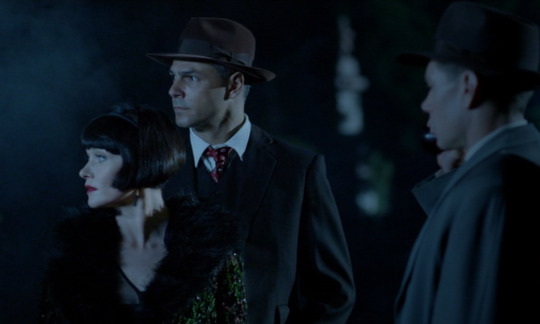

Now you see it, now you see it again
Part 5: “… the intertissued robe of gold and pearl” (Shakespeare, Henry V)
Called the Cemetery coat, it is antique cotton lace, stitched with sequins, bugle-beads and chenille embroidery, with faux fur collar and edging.
‘The original 1920s black net fabric for this swing coat was purchased from an antique dealer. Green, black and chocolate iridescent sequins were added with faux fur trims for movement. The coat was made for a scene in Death Comes Knocking set in a cemetery…’ (MFMM Costume Exhibition catalogue)
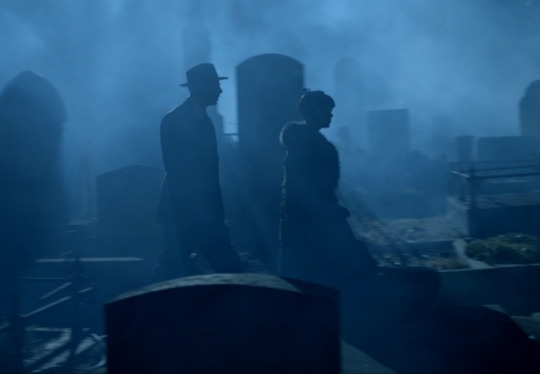
I wanted her to have a lot of panache - and wanted the silhouette of Phryne jumping off the cemetery wall to look like a big beautiful parachute flying then collapsing on the ground. - Marion Boyce
In Season 2, Episode 2 Death Comes Knocking, Phryne wears this bejewelled coat in a late-night entry to the cemetery to investigate the strange circumstances that appear linked to her cousin’s lost memories of a WWI battlefield. The eerie and misty darkness of the surrounds are intercepted not only by police flashlight but by the iridescence of Phryne’s coat.

The interplay of police investigation and Phryne’s personal involvement with the case continues into the interview room and Jack’s office. The relationship between light and dark in terms of mood as well as colour are signified by the coat.
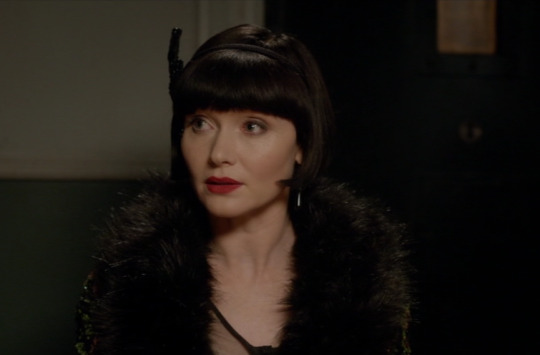

In this episode, our Jack both rejects Madame Bolkonsky’s prognostications of his greatest passion and yet is affronted by Phryne’s dalliance with Warwick Hamilton. Denial and desire are powerful adversaries, rather like the juxtaposition of flashes of light cast by a jewelled coat in a place of the dead, which continue to glisten before Jack throughout the interrogation at the station and subsequent conversation with Phryne in relation to Warwick Hamilton’s motives. Are the jewels a glimmer of light in this shadowed relationship?

The coat reappears three episodes later in Murder à la Mode, an episode that brings together fashion and jewellery as motives for murder. How appropriate to see the magnificent bejewelled coat again!

“While the coat was made with the cemetery scene in mind, Marion felt it was such a gorgeous outfit that needed another look onscreen so it also features later in the ‘fashion’ episode, Murder à la Mode.” (MFMM Costume Exhibition catalogue)
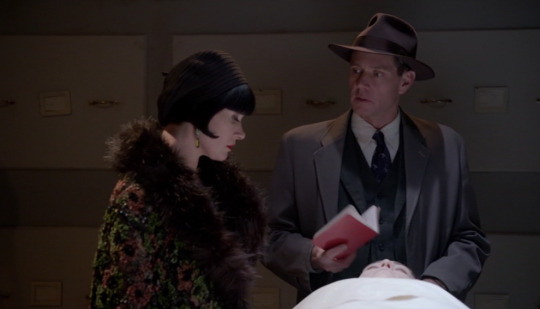
The coat first reappears in the morgue, in parallel to its appearance in the cemetery in the previous episode - although Jack and Phryne are working more as a team and presumably their appearance there together is planned.
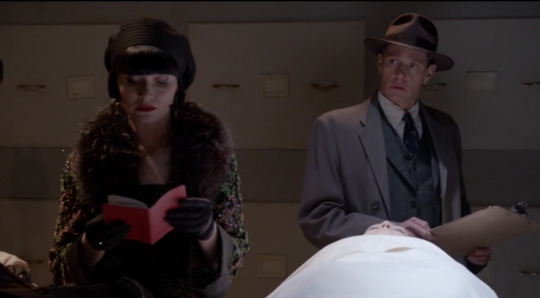
Following this mortuary meeting, there is further questioning by Phryne and Jack of the sisters at the House of Fleuri. Phryne’s coat bedazzles there as missing pearls are discovered in the rear standard of the camera.
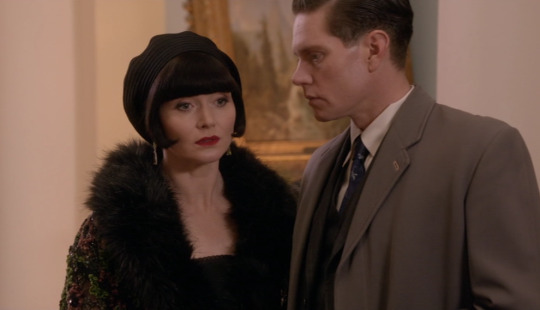
Phryne’s profile in the coat framed by the salon interior is pure cinematographic elegance.

And our Jack learns not to dismiss fashion as frivolous, indeed he admits to its potential to be fatal.
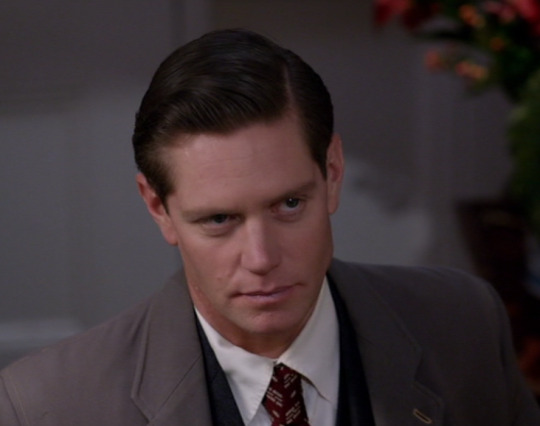
38 notes
·
View notes
Text
Evidence of Intertissue Differences in the DNA Damage Response and the Pro-oncogenic Role of NF-{kappa}B in Mice with Disengaged BRCA1-PALB2 Interaction
The BRCA1–PALB2–BRCA2 axis plays an essential role in DNA homologous recombination repair, defect in which drives genome instability and cancer development. How cells with defects in this pathway respond to DNA damage in vivo and how tumors develop from these cells remain poorly defined. Here, we analyzed several aspects of the DNA damage response in multiple tissues of Palb2-mutant mice in which the interaction between PALB2 and BRCA1 is disengaged. Without any challenge, the mutant mice showed increased endogenous DNA damage. Following ionizing radiation, the mutant mice displayed higher levels of DNA breaks and stronger induction of p53 and p21, but continued DNA synthesis, reduced apoptosis, and accelerated tumor development. The differences in p21 induction, DNA synthesis, and apoptosis between wild-type and mutant mice were substantially more pronounced in the mammary gland than in the intestine, suggesting a potential contributing factor to the increased risk and the tissue specificity of BRCA/PALB2-associated tumor development. Moreover, the mutant mice showed higher levels of reactive oxygen species and constitutive activation of NF-κB, an antiapoptotic transcription factor inducible by both DNA damage and oxidative stress. Treatment of the mutant mice with an inhibitor of NF-κB reactivated apoptosis and delayed tumor development following radiation. Thus, our results also suggest a prosurvival and pro-oncogenic role of NF-κB in PALB2-mutant cells.Significance: This study explores novel tumor suppression mechanisms of the BRCA1-PALB2 DNA damage response pathway and implicates NF-κB activation as a protumorogenic event and possible therapeutic target. Cancer Res; 78(14); 3969–81. ©2018 AACR.
https://ift.tt/2uwEurY
0 notes
Video
vimeo
What infinite heart's-easeMust kings neglect, that private men enjoy!And what have kings, that privates have not too,Save ceremony, save general ceremony?And what art thou, thou idle ceremony?What kind of god art thou, that suffer'st moreOf mortal griefs than do thy worshippers?What are thy rents? what are thy comings in?O ceremony, show me but thy worth!What is thy soul of adoration?Art thou aught else but place, degree and form,Creating awe and fear in other men?Wherein thou art less happy being fear'dThan they in fearing.What drink'st thou oft, instead of homage sweet,But poison'd flattery? O, be sick, great greatness,And bid thy ceremony give thee cure!Think'st thou the fiery fever will go outWith titles blown from adulation?Will it give place to flexure and low bending?Canst thou, when thou command'st the beggar's knee,Command the health of it? No, thou proud dream,That play'st so subtly with a king's repose;I am a king that find thee, and I know'Tis not the balm, the sceptre and the ball,The sword, the mace, the crown imperial,The intertissued robe of gold and pearl,The farced title running 'fore the king,The throne he sits on, nor the tide of pompThat beats upon the high shore of this world,No, not all these, thrice-gorgeous ceremony,Not all these, laid in bed majestical,Can sleep so soundly as the wretched slave,Who with a body fill'd and vacant mindGets him to rest, cramm'd with distressful bread;Never sees horrid night, the child of hell,But, like a lackey, from the rise to setSweats in the eye of Phoebus and all nightSleeps in Elysium; next day after dawn,Doth rise and help Hyperion to his horse,And follows so the ever-running year,With profitable labour, to his grave:And, but for ceremony, such a wretch,Winding up days with toil and nights with sleep,Had the fore-hand and vantage of a king.The slave, a member of the country's peace,Enjoys it; but in gross brain little wotsWhat watch the king keeps to maintain the peace,Whose hours the peasant best advantages. A quote from, William Shakespeare .For more picture and video quotes, check out our site at http://WhoSaid.Xyz
0 notes
Text
Proteostasis and Diseases of the Motor Unit.
PubMed: Related Articles Proteostasis and Diseases of the Motor Unit. Front Mol Neurosci. 2016;9:164 Authors: Rinaldi C, Mäger I, Wood MJ Abstract The accumulation in neurons of aberrant protein species, the pathological hallmark of many neurodegenerative diseases, results from a global impairment of key cellular processes governing protein synthesis/degradation and repair mechanisms, also known as the proteostasis network (PN). The growing number of connections between dysfunction of this intricate network of pathways and diseases of the motor unit, where both motor neurons and muscle are primarily affected, has provided momentum to investigate the muscle- and motor neuron-specific response to physiological and pathological stressors and to explore the therapeutic opportunities that manipulation of this process may offer. Furthermore, these diseases offer an unparalleled opportunity to deepen our understanding of the molecular mechanisms behind the intertissue communication and transfer of signals of proteostasis. The most compelling aspect of these investigations is their immediate potential for therapeutic impact: targeting muscle to stem degeneration of the motor unit would represent a dramatic paradigm therapeutic shift for treating these devastating diseases. Here we will review the current state of the art of the research on the alterations of the PN in diseases of the motor unit and its potential to result in effective treatments for these devastating neuromuscular disorders. PMID: 28082869 [PubMed - in process] http://dlvr.it/N6LSM2
0 notes